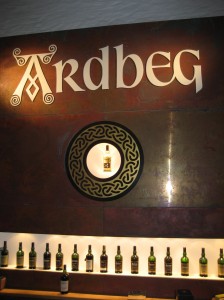Ardbeg Distillery sits at the end of a two-lane highway that shrinks to a single-track road. Those willing to continue on that road find it to be narrow and bumpy with steep hills, blind turns and an otherworldly landscape. It’s appropriate that Ardbeg is the last stop before you venture on, as the whisky is among Islay’s heartiest, with a big peat punch to keep you company along the way.
Distillery Manager Michael Heads came to Ardbeg from Jura two years ago with one goal in mind: don’t mess with a good thing. Ardbeg may not be the best known of Islay’s malts, but it is a dandy. The distillery was closed in the early 1980s and then was on and off again for a period in the mid-1990s. Only in the past decade or so has it seen regular production. And that production has increased tremendously as more people discover and appreciate the malt.
Ardbeg’s biggest fans are The Committee, an official club of Ardbeg enthusiasts from around the world. They are treated to Committee-only releases and have input, according to Michael, on Ardbeg’s bottlings. After all, if the distillery’s biggest fans love a release, or don’t, they are probably pretty reflective of the buying public. It’s a personal market research team.
That road I told you about is Islay’s main road, running through Bruichladdich, Bowmore and Port Ellen. It passes Ardbeg’s neighbors Lagavulin and Laphroaig before letting you jump off at the distillery. The site is lovely, though it’s so close to the ocean you feel as though a big wave could douse the warehouses with saltwater at any moment.
The old maltings area has been turned into the fantastic Old Kiln café, which serves up some fabulous lunches. The café and attached gift shop/tasting room are a great combination of contemporary design and classic distillery structure. The cuisine is also wonderful, and many people make the trek to the end of the main road just to enjoy a healthy and hearty lunch.
With the on and off again production Ardbeg had in the 1990s, their younger whisky expressions were limited for a number of years. Five years ago, however, they had enough quantity and quality from their turn of the century rebirth to bottle a six-year-old they aptly called, “Very Young.” Next was an eight-year-old, “Still Young” followed by the nine-year-old, “Almost There.” In each, you can experience the melding of peat, fruit-tinged spirit and wood. The offerings reach their apex (for now?) with the 10-year-old “Renaissance,” which I find to be a simply exciting dram.
When you continue down that single track road past Ardbeg, you’re stepping back in time. You come across the 8thCentury Kildalton Celtic Cross. There are a couple of 4,000 year-old standing stones. If you stop at Ardbeg before you go down that road, you’re taking a bit of the past with you, as Michael thinks Islay’s peaty malts owe their heritage to the smoky flavors of the first whiskies made a short hop away, in Ireland, more than 1,000 years ago.
However, I suggest stopping at Ardbeg after returning from that single track trek. For as much as Ardbeg owes its flavors to the past, the improvisations Michael and his team give to that ancient art will certainly continue to propel their whiskies well into the 21st Century.

